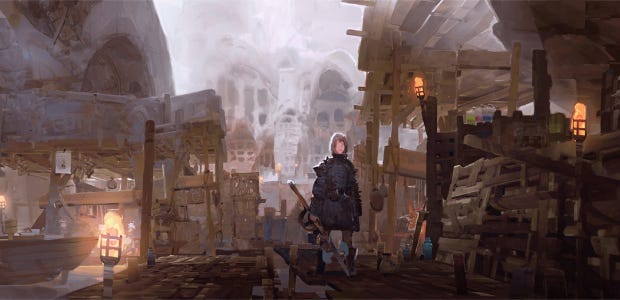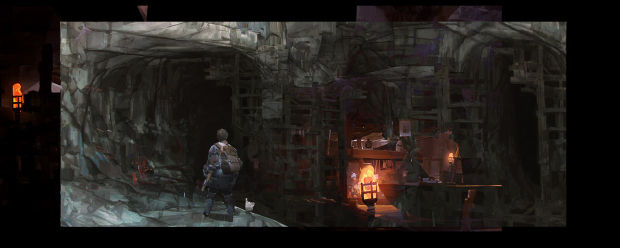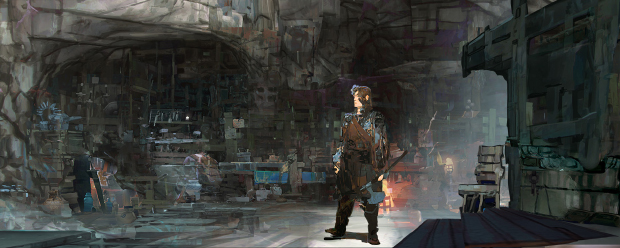Immaculate Conception: Thomas Scholes
How Concept Art Is Made
In this (probably) monthly column, I’ll be looking at the inspiration and techniques of the industry’s greatest concept artists. This month, I talk to environment specialist Thomas Scholes.
One of the things I like so much about Scholes’ work is his ability to blend impressionistic brushwork with a keen sense of three-dimensionality. His paintings are sometimes ambiguous and the textures within them ignore finicky detail, and yet somehow they convey an incredible sense of luminosity and depth that completely enwraps you in the fantasy of that space. Looking at them, you somehow know what it would be like to step into them, what the air would taste like, what it would feel like on your skin.
Take a look at this one, for instance. You can feel the coolness of the shade, the moisture rising from the water, and yet you can also anticipate the gentle heat were you to walk out from under the cover of the trees into the sunlit glen behind. The brush strokes which describe its textures are broad, and still every stone and wooden strut is crisply delineated, weighty and solid. My meagre talents may prohibit me from replicating techniques, but I can mostly recognise them; I look at this, as I look at many of Scholes’ paintings, and really have no idea how he’s done it. I thought I’d better find out.
Scholes speaks thoughtfully and somewhat lyrically about his ability - which, at times, he makes sound almost mystical in inspiration. Dismayingly to those of us with much lesser talents, he’s self-taught and his career coalesced out of his love of creation, rather than a vocation assiduously pursued.
“Honestly, I think I kind of fell into concept art,” he says. “I was just interested in painting. I was interested in creating things. It was definitely in the back of my mind, but I had never really taken a straight path towards it. I was just happy to be learning something, and digital art, and art in general, is something where there’s just no end game, you know? You’ll be learning it for the rest of your life, and I think that’s just what got me hooked.”
As for games, they are “definitely a lifelong passion at this point. I never thought seriously I’d work in games, and lo and behold it ended up happening, and now I couldn’t even imagine myself doing much else, other than perhaps being a hermit in the woods. Although I’d probably still be making my own games and paintings if I was a hermit.”
Games seems to hold a particular attraction to him, more so than concept work for other media - he likes the collaborative nature of game development, the interplay between different disciplines that takes an idea from a painting to a three-dimensional asset, interactive and explorable.
“Coming from my standpoint as an environment specialist, in film I’d feel like more of a background artist, and ‘background’ almost sounds a bit derogatory to me when applied to games. In games, because you’re actually designing a world and a culture when you’re designing environments and architecture, it’s not just the flat 2D plane that you see. You have to consider that the player is going to want to- not just want to, but has the ability, generally speaking- to move around your environment. You have to consider three-dimensional aesthetics, and more than that you just kind of want to give people a feeling that they could be there and that they could explore it.”
I suggest that when he starts drawing something, he’s doing some sort of prototypical level design as well.
“I always try to,” he says. “You don’t always have that opportunity when working for a client or working in a studio, but I always try and think of areas that are partially occluded that people will want to go explore. And you also just want it to make sense, I think, spatially. I really do feel like the concept art process should reflect the 3D process. I think if you can get out ahead of some of those issues that those guys are going to deal with, that’s as much of your job as anything else. In fact, I would argue that it’s most of your job: to just make their lives quicker, easier, and help their results. Although, to be honest, even the best 2D artists, in my opinion, because they don’t work in 3D all day, they will never be as good at interpreting and designing in the third dimension as the 3D team. So to me the best teams always work collaboratively rather than, sort of, as replication.”
So, at the same time as being suggestive of a plausible, functional game space, Scholes tries not to be too prescriptive: he wants the painting to inspire rather than dictate.
“I definitely aim for impressionism,” he says. “I think it’s a great way to respect your audience, you know, allow them a way to participate with the image. I get myself to a place where I can allow my paintings to surprise me, even. Like, that’s such an enjoyable place to me that I’d argue that it’s maybe even more fun for me than a good movie or a good game. When painting’s really good is when I’m creating something that- well, to be honest, ‘creating’ is the absolute wrong word for it. What I find with my work is I’m discovering the painting as I create it, and it’s exhilarating to be able to have that ‘choose your own adventure’ moment with your own work.
“I know this sounds strange to some people, but I do feel it’s important to have a respectful relationship with your art. And if we think of it in those terms, if we force our work to do things it’s often going to be very stubborn, it’s going to fight back or it’s at least going to do it begrudgingly, but if we work alongside, if we collaborate with what’s possible in a painting, I feel like that’s the only way to get the maximum potential out of it. Again, more than that, like I was saying, I think that’s just fun, you know?”
To this end, perhaps, Scholes has recently embarked on a month-long project of daily sketches each of which tries to resist the instinct to over-define, to steer them away from pedantic perfectionism.
“There’s so much obsession and anxiety that can go into making a painting public. It’s this funny thing in art that things can always be better, things can always be improved, they can always be a little more rendered or a little more detailed, whereas if we were all plumbers we would know when the toilet was assembled and fixed or when the sink wasn’t leaking. But with art it’s just neverending.”
We talk a bit about the creation of the pictures for this sketch project, how they seem so layered and luminous. Where does he begin with such an image?
“I think it’s important to start in as many different ways as possible,” he caveats, “but most artists are either draftsmen or painters - basically to say that they either deal in line or with shape. And whether they cross barriers or not, I still feel that there’s a dominant side in most artists. I start with shape. I create shapes, or I borrow shapes.
“With my own personal work, it’s not uncommon for me to re-use something from years ago and mix it in with something from last week. I get a lot of pleasure out of taking what would normally be dead-end sketches and, sort of, stitching them together to create new work, new life.”
I observe that some of the images for the month-long challenge he set himself appear to repurpose bits of previous paintings, manipulating their shape to suggest a receding wall, ceiling or floor. But it goes further than that - he has, in the past, constructed huge asset sets from which he can plunder. A previous month-long project of his was to create a vast array of props, which he can now deposit in his images and rework to give a sense of clutter.
“It’s a bit like collage, and it’s a bit like set dressing. It’s a bit like I have these really cool props from the last episode of my TV show and it’s like, ‘Well, let’s find new creative ways to use them and save the budget and, make our production look all the nicer for it.’ Like, even some of the armour I’ve actually just literally copy-pasted off of character designs I’ve done and placed them in the right spot. From there, you just need to render it a little bit to make it fit, to make it suit.
“With client work, I tend to build that library as quick as possible. I like to have as many different sketches and paintings to pull from, and start to assemble what, in my mind, is not that different than the assets you would find in the game, only they’re two-dimensional.”
Scholes takes me through this very process with the sequence of work-in-progress images you see below:
“This one’s probably at least a year old by now. A very simple scene: characters, some structures, and some stone. I’m adding into it another painting - I liked the properties of light, and you can see that I’ve erased out portions of it in order to keep the parts of the previous painting that I liked but mix it with this painting. And at this point I really just have a feeling of what I want rather than any true idea.”
“And here’s yet another painting that I’m mixing in…”
“And here’s a fourth painting that I’m mixing in. You know, I’ve gotten to this point, you know, probably hundreds of times, and realised that nothing is going to come out of the painting. So this is definitely one of those rare exceptions where, you know, I’m actually really excited and eager to see what comes out of it.”
“It’s not like you can just slap anything together and it’s going to work. You have to be very intelligent and thoughtful about it. And you’re going to fail a lot too. You know, it’s very experimental, and your experiments will fail for sure.”
“I’ve probably at this point mixed in a dozen paintings, some of them from May, some of them from months ago, some of them from years ago.”
(You can see a gif of the above transformation here.)
Re-using his own work, painted in his own distinctive style, is one of the reasons that Scholes work looks so cohesive. It’s why he doesn’t use photography as a means of creating texture: “For me, I like to have that control over design. I like to have that control over colour and texture and frequency of detail.”
And as for colour - I wonder how his images seem consistent. Wouldn’t this collage approach end up introducing elements that jar with the existing image’s palette? Scholes sees this as a necessary challenge of the process.
“I asked a favourite artist of mine, his name is Igor Alban Chevalier, sometimes known as The Black Frog, and he gave me the advice to just put a lot of colour down and keep what works. So for me, my process, my approach to colour, is actually to make an absolute mess, just to put so much colour down. And, you know, I definitely want it to harmonise, but generally speaking, with the amount of editing tools in Photoshop, if you can master those you don’t have to worry too much about colour harmony because you can always bring in harmony later.”
Some digital artists tend towards using Photoshop much like they would a physical canvas, albeit one with an undo button, and largely ignore the stranger facilities offered by the program, that have no analogues in real-world painting. Scholes is certainly not this kind of artist. His works are busy with hundred of layers and clipping masks. “I use just about everything,” he says. And yet his work is free of the intentional artifacting or patterning that has become a strong trend within digital speedpainting: Scholes work feels lush and painterly, too - he’s at his best when dealing with the organic, or at least the non-orthogonal. There’s something living and lived-in about his worlds, something, dare I say it, a bit magical.
“My interest is always in things that are a little bit more storybook, worlds that have a bit of surrealism in them,” he says. “I feel like we kind of already have enough of reality. Why not create things that couldn’t exist? Not just situations that could exist, like a post-apocalyptic America or something. So my inspirations and the things that I love are always more on the side of Studio Ghibli’s works, or the Final Fantasy series and Legend of Zelda. I really do hope the industry shifts back towards fantasy and a little bit less of reality.”
With the sorts of worlds Scholes can conjure, how could they resist?
See more of Thomas Scholes' work, in more respectable resolutions, at his own site.



























